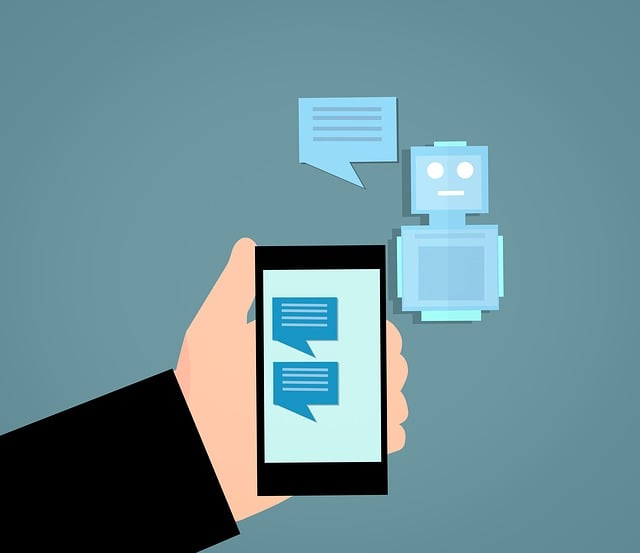“Unleash the power of conversational intelligence with your very own Generative AI Chatbot! This comprehensive guide navigates you through the process, from understanding the fundamentals of Generative AI and its integration with chatbot technology, to a detailed step-by-step development process. Learn how to train and enhance your chatbot’s performance for optimal user engagement. Discover strategies to create engaging, contextually relevant, and intelligent AI chatbots that revolutionize interactions.”
- Understanding Generative AI and Chatbot Technology
- Designing and Developing Your Chatbot: Step-by-Step Guide
- Training and Enhancing the Chatbot's Performance
Understanding Generative AI and Chatbot Technology

Generative AI refers to a powerful class of artificial intelligence that can create new and diverse content, such as text, images, or even music, by learning patterns from vast datasets. This technology has revolutionized the way we interact with machines, moving beyond rule-based systems towards more natural and creative conversations. At the heart of this transformation are AI chatbots, which use generative models to understand and respond to user queries in a dynamic and contextually appropriate manner.
Chatbots have evolved from simple rule-following programs to sophisticated conversational agents capable of handling complex tasks. They utilize Natural Language Processing (NLP) and Machine Learning techniques to interpret human language, generate relevant responses, and learn from each interaction. By leveraging generative AI, chatbots can provide more personalized, nuanced, and engaging interactions, making them indispensable in various sectors, from customer service to content creation.
Designing and Developing Your Chatbot: Step-by-Step Guide

Designing and Developing Your Chatbot: Step-by-Step Guide
1. Define the Purpose and Scope: Begin by clearly outlining what your AI chatbot will do. Identify its primary functions, target audience, and conversational scenarios. This step is crucial for setting realistic expectations and guiding your development process.
2. Choose a Development Platform: Select a suitable platform or framework to build your chatbot. Options range from cloud-based services like Dialogflow or IBM Watson to open-source libraries such as Rasa or ChatterBot. Each offers different levels of customization, natural language processing capabilities, and integration options with other AI technologies.
3. Create a Conversational Flow: Design the conversation flow by mapping out user inputs and corresponding responses. This involves defining intents (user intentions) and entities (relevant data within user inputs). Organize these into a structured dialogue tree to guide the chatbot’s interactions, ensuring a logical and engaging user experience.
4. Train and Train Your Model: Depending on your chosen platform, train your AI model using labeled datasets or conversational examples. The more diverse and relevant the training data, the better your chatbot will perform. Fine-tune the model’s parameters to optimize its understanding of user inputs and generation of contextually appropriate responses.
5. Integrate with Communication Channels: Decide where your chatbot will reside—a website, mobile app, or messaging platform like Facebook Messenger or Slack. Integrate it seamlessly into these channels using provided APIs, enabling users to access its functionality without friction.
6. Test and Iterate: Rigorously test your chatbot across various scenarios and user inputs. Continuously refine the conversation flow, improve response accuracy, and enhance its ability to handle edge cases. User feedback is invaluable during this phase, helping you identify areas for improvement.
Training and Enhancing the Chatbot's Performance

Training an AI chatbot is a complex process that involves feeding vast amounts of data to teach it patterns and responses. This data often includes text from diverse sources like books, articles, and conversations to ensure broad knowledge. The quality and diversity of training data significantly impact the chatbot’s performance, accuracy, and ability to understand user queries.
Once trained, enhancing a chatbot’s capabilities requires continuous learning and adaptation. Techniques such as fine-tuning, where models are updated with specific domain knowledge or user feedback, can greatly improve their responses. Regular interactions with users also help refine the chatbot’s understanding of language nuances, ensuring it evolves to better assist its human counterparts over time.
Building a generative AI chatbot is an exciting journey that combines cutting-edge technology with creative design. By understanding the fundamentals of generative AI and chatbot technology, you can effectively navigate the development process. Following a structured guide, training your chatbot with diverse data, and continuously enhancing its performance are key steps to creating an engaging and intelligent AI chatbot. Embrace the power of these virtual assistants, as they revolutionize the way we interact and engage in everyday conversations.
